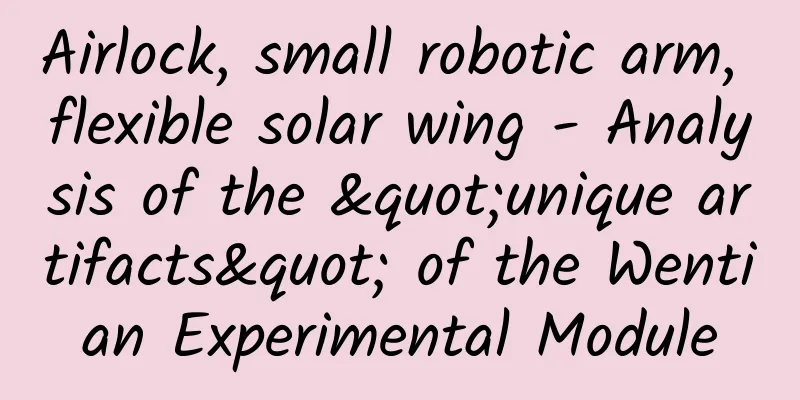Airlock, small robotic arm, flexible solar wing - Analysis of the "unique artifacts" of the Wentian Experimental Module

|
Xinhua News Agency, Wenchang, Hainan, July 24 Title: Airlock, small robotic arm, flexible solar wing - Analysis of the "unique artifacts" of the Wentian Experimental Module Xinhua News Agency reporters Li Guoli, Zhao Yeping and Zhang Ruijie On July 24, the Long March 5B Yao-3 carrier rocket carrying the Wentian experimental module was ignited and launched at the Wenchang Space Launch Center in my country. Photo by Xinhua News Agency reporter Li Gang On the afternoon of July 24, as the Long March 5B Yao-3 carrier rocket soared into the sky, the first experimental module in the construction phase of my country's space station and the heaviest spacecraft launched by my country so far, the approximately 23-ton Wentian experimental module, was launched into space. The Wentian laboratory module has a total length of 17.9 meters and a diameter of 4.2 meters, making it "stronger" and "sturdier" than the Tianhe core module. It also has three "unique artifacts": an airlock cabin, an extravehicular area exclusively for astronauts; a small robotic arm that is more dexterous and precise to operate; and flexible solar panels that can collect energy for the entire space station. Airlock: Astronauts' dedicated exit area Since the launch of the space station mission, Chinese astronauts have conducted multiple extravehicular activities. The exit hatch on the Tianhe core module is called the "node module", which has multiple functions for spacecraft docking and parking and astronauts' extravehicular activities. There are many equipment, pipelines and cables in the cabin. After the launch of the Wentian experimental module, astronauts will have a dedicated extravehicular area for extravehicular activities in the future - the airlock. According to Zhang Hao, chief designer of the space station system of the Fifth Academy of China Aerospace Science and Technology Corporation, the airlock is a round cabin with a square outside and a larger cabin capacity, a wider door, and a cleaner cabin. In the future, the airlock will become the main exit channel for the entire space station system. The space for astronauts to carry out extravehicular activities in the node module is about seven or eight cubic meters, while that in the airlock module can reach twelve or thirteen cubic meters. The airlock module is cleaner than the node module, as it is only equipped with equipment related to extravehicular activities, without the constraints of other pipelines and cables. The diameter of the cabin door is 1 meter, which is 15 centimeters larger than the diameter of the node module door. "Astronauts can be more relaxed and at ease when entering and exiting here. They can also carry large equipment to work outside the cabin, which greatly improves their extravehicular capabilities," said Zhang Hao. The Wentian Experimental Module has a total of 22 standard payload interfaces. In the next decade, scientific experimental payloads carried by the space station can be accurately "delivered" to their corresponding standard payload interface positions through the robotic arm, and can be "plug and play" without the need for astronauts to leave the module for manual operation. Small robotic arm: "Short and powerful", can independently complete extravehicular care Like the Tianhe core module, the Wentian module is also equipped with a robotic arm. Compared with the large robotic arm of the core module, which has a deployment length of 10 meters and a maximum load-bearing mass of 25 tons, the robotic arm of the Wentian module is shorter and more powerful. Zhang Hao introduced that the large robotic arm has a long enough arm, a larger transfer range, and an operating radius of nearly 10 meters; it is strong enough, like a "strongman", and can grab and transfer a complete spacecraft. In comparison, the small robotic arm of the Wentian laboratory cabin is about 5 meters long and has a carrying capacity of 3 tons, but this "little hand" is designed to grasp small and medium-sized equipment and perform more delicate operations. For example, it can independently complete the installation, replacement and other care operations of extravehicular payloads without the need for astronauts to leave the cabin, which can effectively save the astronauts' on-orbit workload. The large and small robotic arms can also be used together to form a combined arm of about 15 meters to carry out more extravehicular operations. "We can regard the large and small robotic arms as two human hands, handing over things to each other and working together; we can also clench the two arms together to form a longer robotic arm, which can perform some operations and crawling needs covering the entire surface of the space station," said Zhang Hao. Flexible solar wing: currently the longest and largest in China The solar panels carried by the Wentian laboratory module are currently the longest and largest flexible solar panels in China, breaking the record for the use of solar panels on Chinese spacecraft in orbit. According to Zhang Hao, the length of the single-wing solar wing array of the Wentian experimental module plus some mounting structures is nearly 28 meters, and the length of the two solar wings when fully unfolded is nearly 56 meters, which is larger than the size of the three modules of the space station combined. The area of a solar wing array can reach more than 100 square meters, which will effectively collect more solar energy and provide sufficient energy for the operation of the space station. "Such a large solar wing can generate 9 kilowatts of electricity per wing and 18 kilowatts per wing, with an average daily power generation of more than 430 degrees. After rendezvous and docking with the core module, it can meet the electricity needs of the entire space station," said Zhang Hao. The solar wing of the Wentian Experimental Module has a large area and great flexibility. Song Xiaoguang, deputy chief designer of the GNC subsystem of the Wentian Experimental Module of the Fifth Academy of China Aerospace Science and Technology Corporation, said that this solar wing is only slightly harder than clothes and adopts dual-axis control, so it can adjust its direction at any time without adjusting the attitude of the cabin. After the in-orbit construction of the space station is completed, a solar panel on the Tianhe core module will be transferred to the tail of the resource module of the Wentian laboratory module. At that time, the Wentian laboratory module will become a veritable "main power station", providing continuous power and energy for the complex. Source: Xinhua News Agency |
>>: Do wild boars eat better or worse after they move into the city?
Recommend
How to make users believe in your product?
Before users buy a product, their biggest concern...
Beware! The “strongest invasive pest on earth” is entering its active period
As the weather warms up, red fire ants enter thei...
How shared bikes make profit from "impossible" to "possible"
In two articles I wrote recently, I talked about ...
How do brands leverage the marketing opportunity during Chinese Valentine’s Day? Come and learn...
Whether in reality or in literary works, we all y...
Before going to the cinema to watch the New Year's blockbuster, you must read this epidemic prevention reminder carefully
Spring Festival Holiday Many New Year blockbuster...
Major live streaming sales events in the first half of 2020
2020 can be said to be the year when live streami...
Look carefully, there is a big truck parked in this zoo!
In our zoo, every time autumn comes, we have a su...
Google may force Android phones to encrypt in the future
Lollipop system encryption options According to f...
78 lines of Python code to help you reproduce WeChat message withdrawal!
Python once said to me: "Time is running out...
How to quickly increase the popularity of your live streaming room?
Live streaming has become a standard sales method...
Do animals sleep well? They sleep standing up, hanging upside down, with their eyes open...
Sleeping is an indispensable behavior for us huma...
Can't drink boiled water or overnight water? I finally understand after reading this...
All along “Drink 8 glasses of water every day” It...
Trumpchi New Energy released the EV+ solution, Zhang Ruoyun appeared at the Trumpchi booth to support
On April 25, the 18th Beijing International Autom...
Data statistics interface - interface analysis data interface
WeChat public platform launched an invitation-bas...









